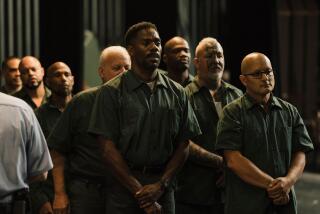Review: Jessica Chastain plays the artist who painted Sitting Bull in the inert history lesson ‘Woman Walks Ahead’
In “Woman Walks Ahead,” a handsome snooze of a historical drama, Jessica Chastain plays Catherine Weldon, a widowed New York City artist who travels to a North Dakota reservation in 1890 hoping to paint a portrait of the famous Hunkpapa Lakota Sioux Chief Sitting Bull (Michael Greyeyes).
The real-life particulars were somewhat different, as they often are. Weldon’s given name was Caroline, not Catherine. She was divorced, not widowed, and her 1889 westward journey sprang less from her artistic aspirations than from her deep concern for Native American rights. (She did meet Sitting Bull and painted several portraits of him, some of which survive to this day.) But deviations from the historical record aren’t a problem in and of themselves; it’s what those deviations add up to (or don’t), and what they say about the motivations of the artists behind them.
Some are fairly easy to grasp, such as the way cinematographer Mike Eley shoots and prettifies the landscape, all lovely purplish sunsets and golden wheat fields. It’s also plain to see why British director Susanna White cast Chastain and Greyeyes, both as picturesque as their surroundings, if also significantly younger than their real-life counterparts.
Not every decision has such a clear rationale. It’s unfortunate that Steven Knight’s screenplay opts to tell of a painter who stumbles into activism, rather than an activist who also happens to be a painter. Perhaps it was easier to conceive of a primly naive heroine who knows little about the trouble she’s getting herself into, the better to underscore the incongruity of her interactions with Sitting Bull. Leaching politics from the frame is fairly common storytelling practice, but in this case, it also drains the protagonist of one of her more interesting attributes.
What’s left doesn’t give Chastain a whole lot to play aside from good manners, sharp comebacks and the kind of flinty resilience that has become the actress’ stock-in-trade. Upon arriving in North Dakota, Catherine immediately butts heads with the local authorities (Ciarán Hinds and Sam Rockwell, both excellent), who order her back to New York. She deflects their hostilities but is rewarded for her troubles by getting spat on then brutally beaten by some of the other men in town, who don’t take kindly to anyone getting friendly with the local Lakota population.
Mostly, though, Catherine spends time on the reservation, and with the help of a local lawman (Chaske Spencer) who happens to be Sitting Bull’s nephew, she secures an awkward audience with the legendary chief. He agrees to sit for a portrait in exchange for $1,000 — a small fortune, but times are hard. Now a farmer who prefers a bowler hat to a feathered headdress, Sitting Bull has long moved on from Little Bighorn. That’s more than can be said for the white townsfolk, who seethe and tremble from a careful distance.
Sitting Bull’s conversations with Catherine are a mix of cross-cultural banter and gradual, mutual understanding. Their bond is occasionally complicated by flickers of erotic attraction that the film continually hints at — when she asks him to wear his buckskins for the portrait, he disrobes with earthy immodesty — without ever allowing them to take root.
That much, at least, appears to be true to reality: Catherine never becomes Sitting Bull’s lover, but she does become his confidante, a passionate supporter of his people’s rights. Her arrival coincides with that of a powerful general (a scarily inscrutable Bill Camp) and the discussion of a new allotment treaty, one that will severely limit the Sioux’s land and food rations if passed. Her painting persists, but it soon takes a backseat to the more urgent cause of her advocacy.
White, who directed the fine John le Carré adaptation “Our Kind of Traitor” (2016), builds her lead actors’ rapport nicely enough. Inhabiting the role of an icon of Native American resistance is no small feat, but Greyeyes, a Canadian actor of Plains Cree descent, draws you in with his wry wit and quiet gravity. He makes Sitting Bull a fascinatingly conflicted figure, someone who spends what he knows will be his final days with one eye locked on the tribal rituals of the past, and the other on the grim realities that await on the horizon.
“Woman Walks Ahead” tries to shine a critical light on some of those realities — including the devastating Wounded Knee Massacre, which gets a polite end-credits shout-out — and to honor the indigenous men, women and children whose way of life was upended by an insatiable doctrine of American conquest. That particular tragedy continues to this day, as evidenced by the recent protests at Standing Rock, the same reservation where Sitting Bull was killed more than a century prior. Present-day resonance, alas, proves as distant as persuasive history in this timid, well-meaning and ultimately futile movie.
------------
‘Woman Walks Ahead’
(English, Lakota dialogue with English subtitles)
Rated: R, for brief violence and language
Running time: 1 hour, 42 minutes
Playing: Arclight Cinemas, Santa Monica
See the most-read stories in Entertainment this hour »
Movie Trailers
More to Read
Only good movies
Get the Indie Focus newsletter, Mark Olsen's weekly guide to the world of cinema.
You may occasionally receive promotional content from the Los Angeles Times.











